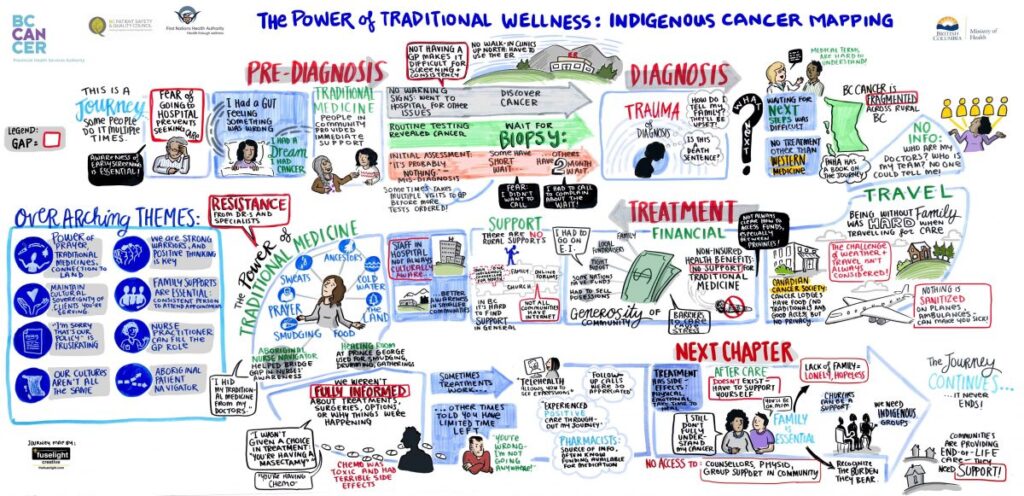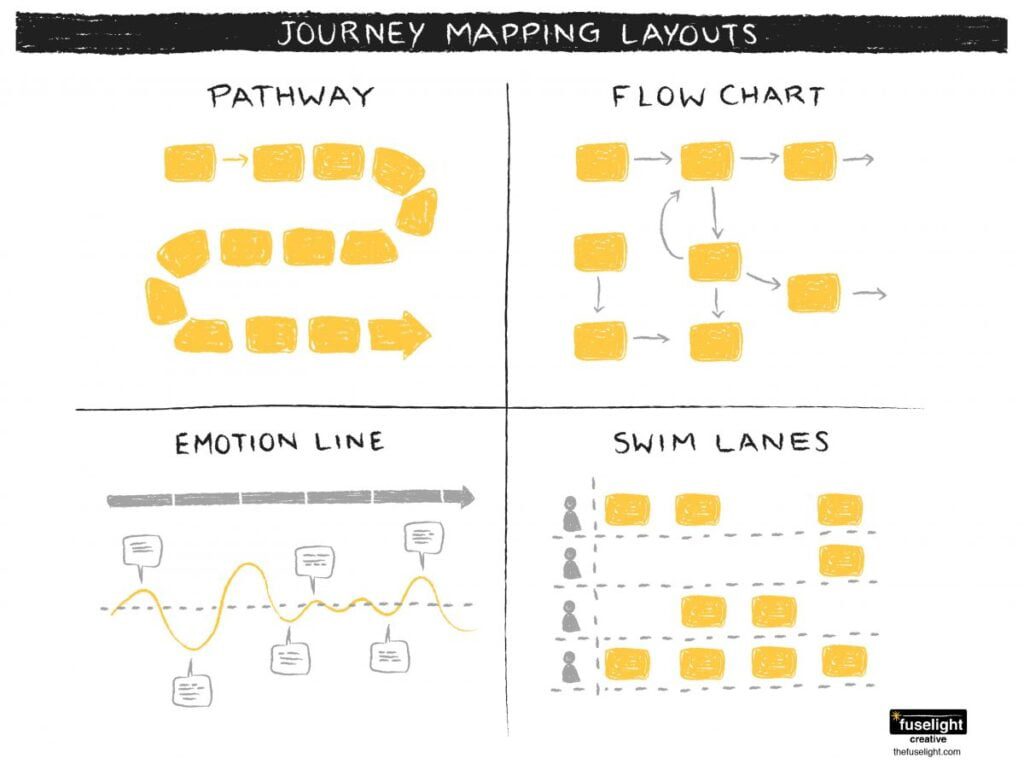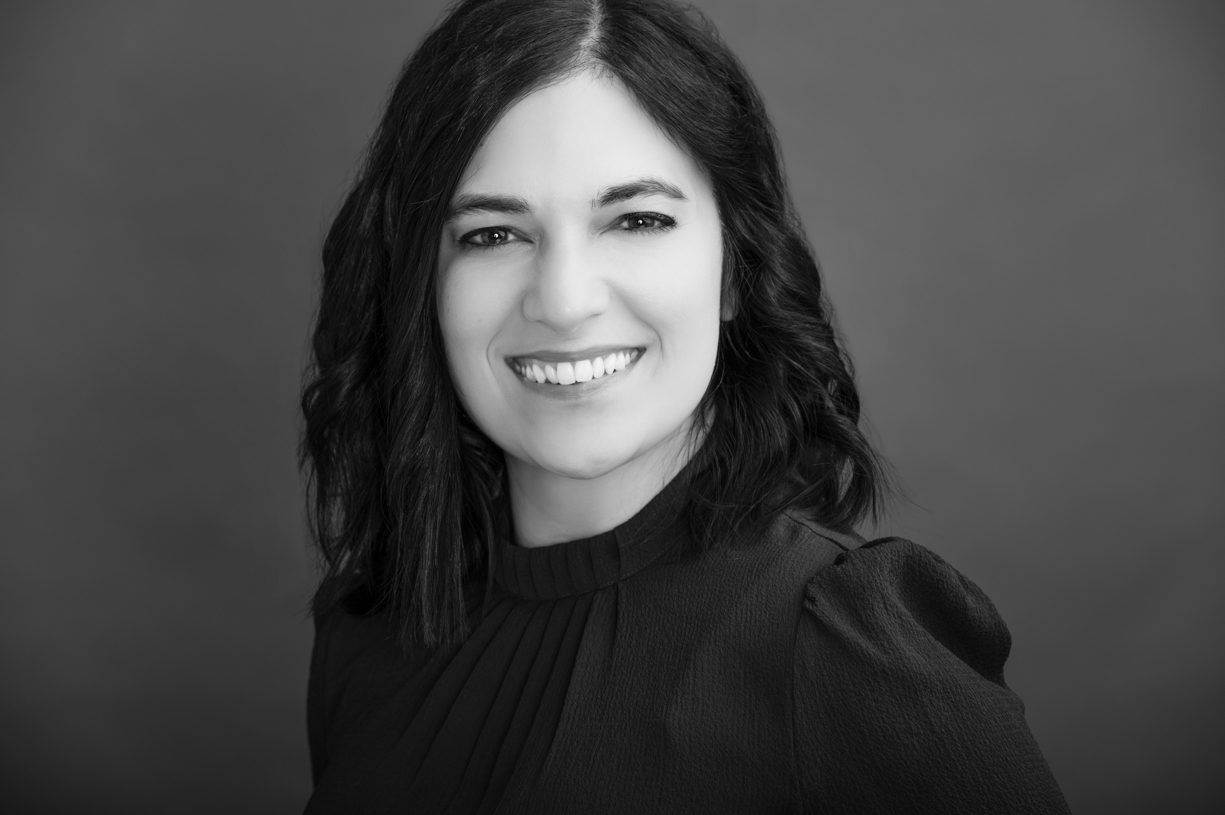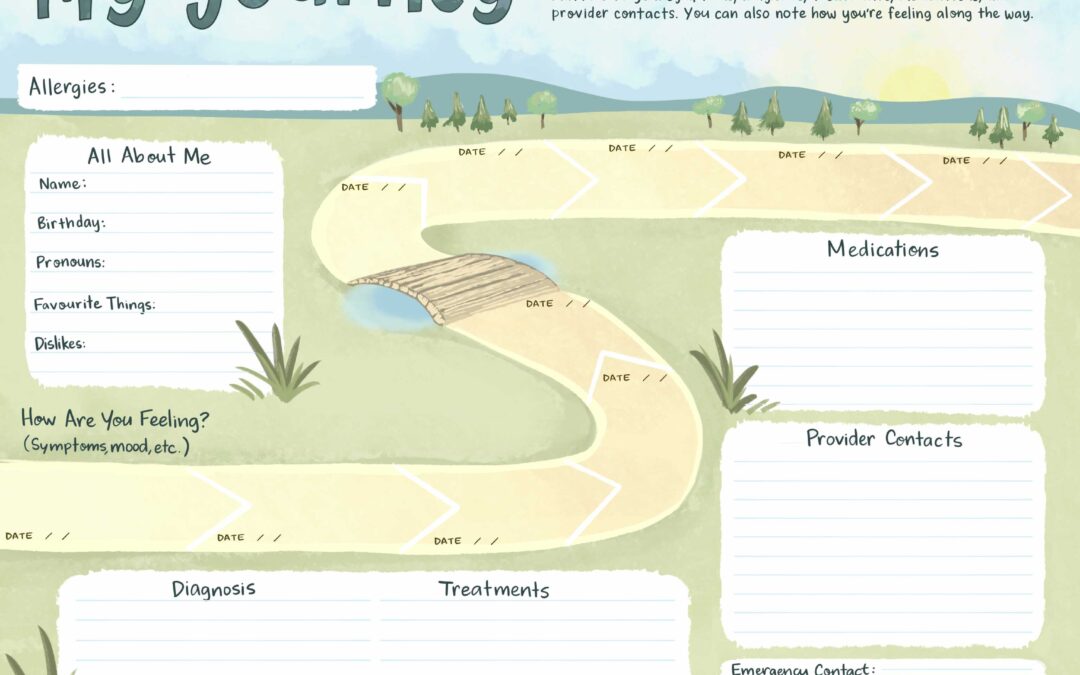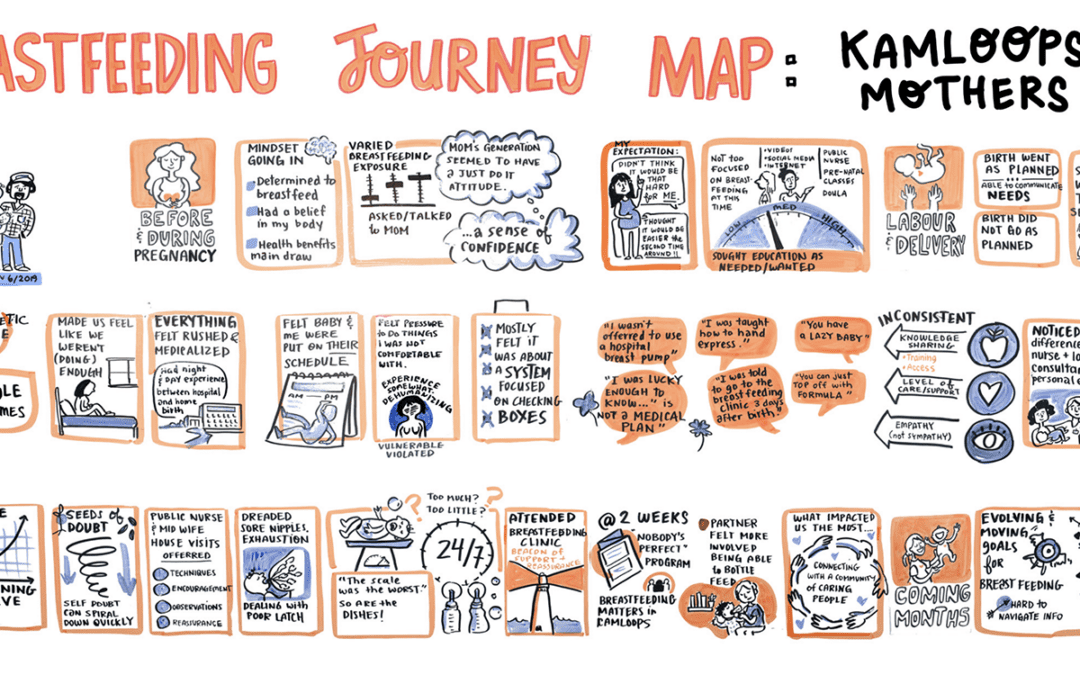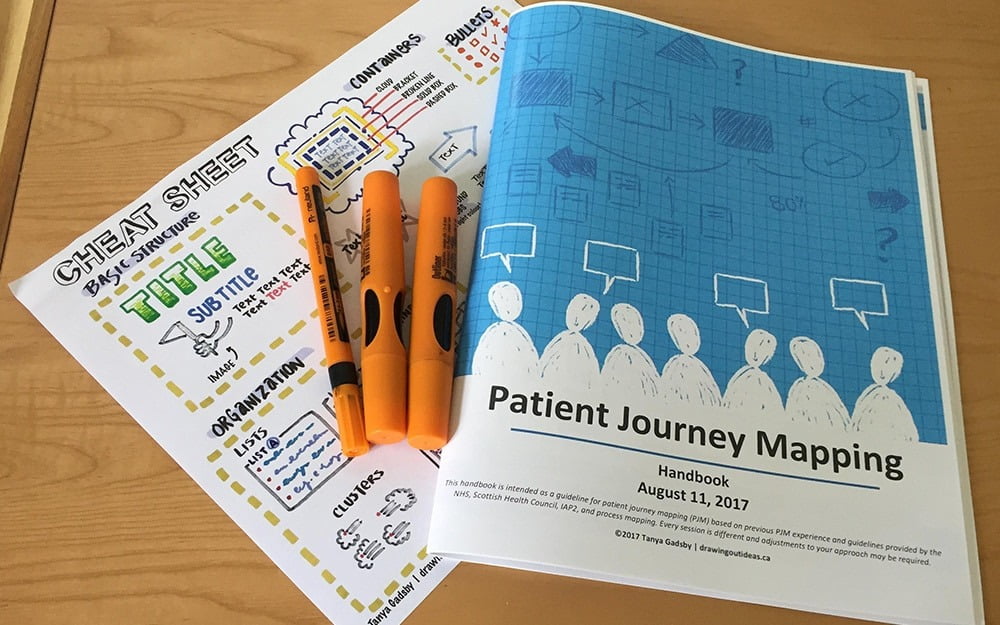Journey mapping is the plotting of experiences to understand the gaps, successes, and challenges in a health care journey.
People receiving care are the only ones who experience all aspects of the journey – from hospital, to community, to specialists, to home, and transitions in between. This voice should be central when making sustainable and meaningful improvements to the health system, and journey mapping is a tool for facilitating a better understanding of what is working or not working.
There is no “right way” to journey map. However, most journey mapping is done in face-to-face sessions: with an individual, in a group setting with people who have been through similar journeys, or a group of people who have received care and clinicians.
Patient Journey Map of Indigenous peoples’ experience receiving cancer care. For more details on this session, visit BC Patient Safety & Quality Council.
The map can be created using sticky notes, simple boxes and shapes, or engaging visuals. It can be structured as a linear pathway, a flow chart with different “loop backs” and “dead ends,” an emotion line, swim lanes, or an entirely custom layout.
Journey mapping can be structured as a Linear Pathway, Flow Chart, Emotion Line, Swim Lanes, or an entirely custom layout.
No matter the approach, the most important part of preparing for a face-to-face mapping session is creating as safe a space possible for people to open up about personal experiences. These experiences may be difficult or traumatic, or it may be the first time people are being asked to share feedback about their care. The more welcoming and well planned the space, the better able people can open up and share their perspective.
Tips for Creating a Safe Space
Be Transparent About the Process
When inviting people to participate in the mapping, be open about the purpose and process of journey mapping, what it is / is not, and the format you’ll be using for the session.
There should be a strategy for how the completed map will be used – for example, maybe it’s understanding gaps and planning solutions for closing them, implementing ideas participants share, or developing a toolkit for providers and people receiving care. Journey mapping should never be done as an engagement exercise or “nice-to-have” visual; the journey has real value in making sustainable changes to the health system.
It’s also important to emphasize that anything shared in the session will not impact the people’s care (even if negative experiences are shared).
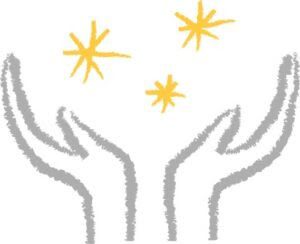
“What Helps You Feel Supported?”
Asking people what helps them feel supported is key to creating a safe space in the session.
Maybe it’s building in frequent breaks, hosting the session in a neutral location, providing healthy snacks, or helping with childcare so people aren’t out-of-pocket.
The needs of people will vary by community, culture, experience, and any number of other factors. Avoid making assumptions about what people need – answers will be different for everyone, so aim to be curious and flexible.
When bringing a journey mapping session to a community, partner with a community member to help plan the session. They’ll know what works best for their community and can connect you to local supports.
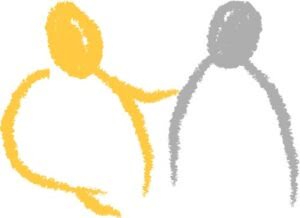
Support People
People should feel welcome to bring a chosen support person to the session (family member, friend, or care provider).
Depending on the focus of the mapping, it may be beneficial to have a counsellor or therapist available that people can speak to privately if feeling distressed. At First Nations journey mapping sessions, an Elder is often included both to provide support and to open and close the session with traditional prayer.
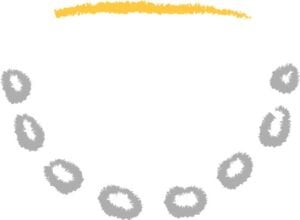
The Meeting Space
A Comfortable Space
The meeting room influences the mapping process tremendously. A welcoming space with windows and plenty of room to move around will help people feel relaxed, and therefore better able to reflect on their experiences.
Location
Key items to consider for the location:
- Is the meeting location easy for people to access?
- Are you asking participants to travel great distances? (Possibly consider bringing the session to them!)
- Is the meeting room in a building where people received care? For example, people who have had traumatic experiences in hospital may not feel relaxed in a hospital meeting space. An off site, neutral meeting space would be a better fit.
Quiet Space
If possible, have a quiet, private room available where people can go if feeling upset or they need to speak privately with a counsellor.
Seating
A u-shape of chairs with the journey map at the front works well for most mapping sessions. Everyone can see the map as it’s being created, and see each other. Consider having alternative seating such as cushions, beanbag chairs, yoga mats, or a couch. People should feel welcome to stretch and move around the space.
Fidget Items
Many people like to keep their hands busy when thinking deeply, so have a mix of “fidget items” like pipe cleaners or stress balls available. Doodling is proven to aid in thinking, so pens and paper are great additions.
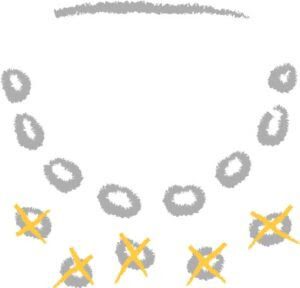
No Observers
Because people are sharing very personal experiences, journey mapping is not a setting for people who only want to observe. The participants in the space should be limited to just chosen support persons, the facilitators, a minute taker (if needed), and a counsellor or therapist.
Also consider the clinicians you have in the space, whether invited by participants as a chosen support, or the therapist/counsellor in the room. If participants are being asked to provide insight into positive and negative experiences, this may be challenging if their care provider is in the space (see “Quieter Voices” section below for ways of gathering anonymous feedback).
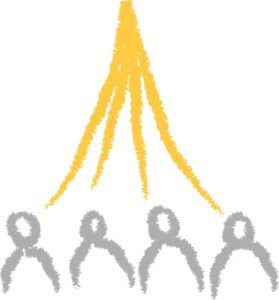
Setting Shared Values
At the start of a session, write up “Shared Values” for creating the map together. A few common values include:
- You can choose to share as much or as little as you want
- Participation is voluntary
- We’re focusing on what happens the majority of the time in the journey, not very rare or specific experiences
- No names or specifics will be captured
- Take turns speaking
- Respect each other’s unique experiences and don’t invalidate another person’s perspective
- Everyone is free to move about the room, take a break, or leave
- It’s ok to cry (or laugh!)
Open it up to the group to add to the values before proceeding with the journey mapping.
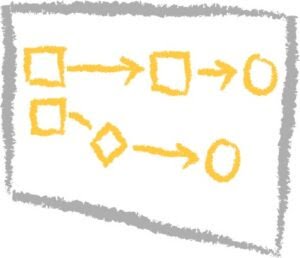
Style of the Journey Map
Mapping can be done in a variety of formats – from simple sticky note maps, to maps made of lines and shapes, to more visual maps that use characters and scenes. Journey mapping is most engaging for participants when the basics of Flip-Charting and Graphic Recording are used to organize the map. This helps keep content clear and easier for people to make sense of the journey.
Visual maps are highly effective at facilitating understanding of complex journeys, picking out milestones at-a-glance, and also conveying the emotion of the journey. Participants will more readily connect to the map, can easily identify areas where more detail is needed.
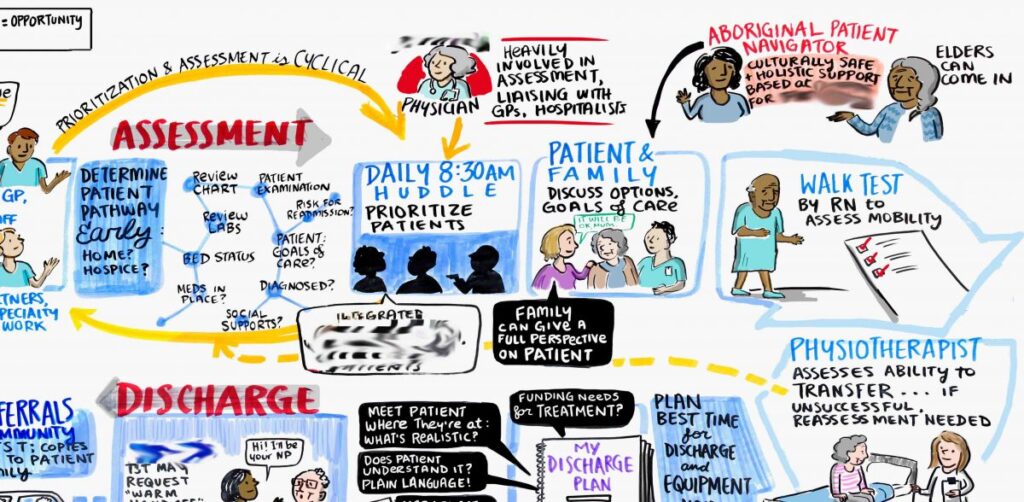 Detail of a journey map for a discharge process from hospital (confidential info blurred)
Detail of a journey map for a discharge process from hospital (confidential info blurred)
Although most maps are created on paper, working on a big whiteboard will allow for the greatest flexibility in moving items around and helps communicate to participants that nothing in the map is permanent or unchangeable.
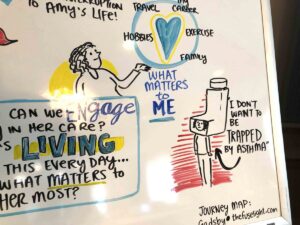
Excerpt from an asthma journey map created on a whiteboard.
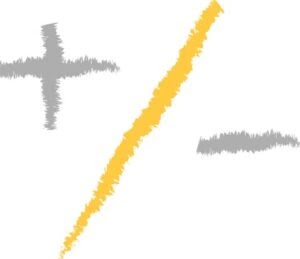
Incorporating Feedback
If the map will be created with a group, and not one-on-one with an individual, emphasize that the map is a “snapshot” of experiences. It is not meant to represent the only journey, but serves as a high-level, bird’s eye view of a collection of experiences.
As the map is being created, it’s important to pause throughout the session to reflect and invite corrections, changes, or additions. Stay open to whatever the group expresses – surprising insights often come up during journey mapping. Being open to feedback ensures the map is as accurate as possible, and also demonstrates to the group that the map is theirs and not a standalone creation that can’t be changed.
A final walkthrough of the map at the end of the session allows people to take in the entire journey and make any final additions.
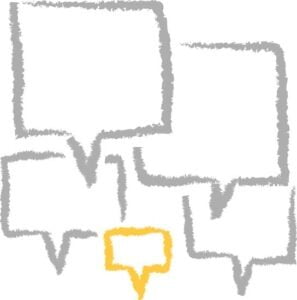
Quieter Voices
Sticky Notes for Anonymous Input
Sometimes people don’t want to speak in a group, or don’t feel comfortable sharing a point of view or experience. Provide each person with a set of sticky notes to write anything that they feel can’t be said in the group. A facilitator periodically collects the sticky notes and they are reviewed with the group and added to the map.
Journals
Another method of collecting thoughts anonymously is to provide each person with a small journal to write their thoughts. These journals are collected after the session and reviewed by the facilitation team.

Thank-You Gift
Thank participants for their time and contribution by providing each with a gift card and compensation for any travel expenses. All participants should receive a digital copy of the journey map 1-2 days after the session.
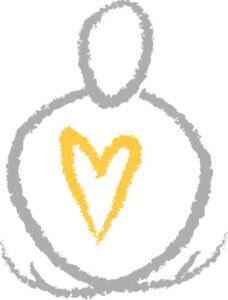
Facilitator Support
It takes tremendous energy to host a mapping session, particularly when people are sharing intense personal experiences. The needs of your facilitation team should not be overlooked. Have a plan for a facilitator debrief after the session, ask the team what they need to feel supported, and allow time for self-care.
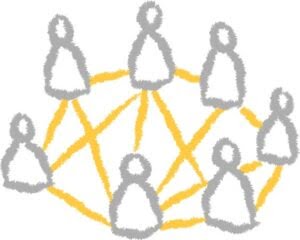
Keeping Participants Involved / Updated
Participants deserve to know how the map is being used – after all, it’s because of their generosity of time and perspective that the map is even possible. Offer to include participants on a private mailing list so updates can be provided on how the map is being used and concrete actions that have been implemented. These updates might be every 4-6 months or yearly.
The list above is intended as a general guide for creating a safe space – it’s not always possible or appropriate to implement all of these items. The needs of people will also vary based on their journey, perspective, culture, community, background, and any number of different factors. Ultimately, it’s important not to take a cookie-cutter approach to journey mapping. Even if you’ve hosted a journey mapping session before, always approach each session with curiosity and flexibility to what the group needs.

